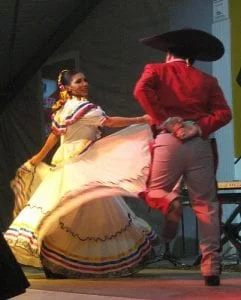La Raspa is a folk dance from eastern Mexico. This dance is often incorrectly called the Mexican Hat Dance or Jarabe Tapatio. According to Mark Pedelty. author of “Musical Ritual in Mexico City,” both of the latter titles actually belong to a dance from Jalisco, which includes complicated and flirtatious movements.
In contrast to the Mexican Hat Dance, the steps for La Raspa are very simple, involving a bleking step (hopping in place with alternate heels thrust forward) for 16 counts, then a running step (while linking elbows) for another 16 counts.
Origin of the Dance
La Raspa is said to have begun in Veracruz, a state that has a major port city off the Gulf of Mexico. With shipments of trade goods also came music and dance from around the world. Modern Mexican folk dances, like La Raspa, are mixtures of Aztec, Mayan, Yaqui, African and European movements–sacred and secular–which were forged together as many cultures intermingled over the centuries.
Traditional Attire
Veracruz was strongly influenced by the Spaniards who settled there, which is noticeable in the clothing. When dancing La Raspa, the traditional garb, according to the Houston Institute often includes “white guayabera pants and shirts and red waist sash and straw hat [for men]. The women [would] wear imported white lace dresses; their hair up in buns in a comb and shawls, or rebozos, accompanied by fans.”
Etymology
The origin of the name “La Raspa” has been lost in time. The name possibly comes from the verb “Raspere”, which is an Old Germanic word meaning “to grate upon,” states the Merriam Webster Dictionary, from where we get the word “raspy.”
This could refer to the Guiro, an instrument played all over Latin America, according to Viva Quetzal, which produces a rhythmic scratching sound when a scraper is rubbed over its indentations. Scratching could also refer to the chicken-like movement the dancer uses with his legs (with arms akimbo like chicken wings) when he dances La Raspa.
La Raspa and Children
The minimalist movements of this dance are often taught to school children. Not only does it promote physical education, but, as the Ballet Folklorico Mexico notes, another purpose of doing so “is to encourage children to carry on the dances and traditions of Mexico and other cultures.”
 FolkDanceWorld.Com International Folk Dances
FolkDanceWorld.Com International Folk Dances





I just couldn’t go away your website prior to suggesting that I extremely loved the usual information a person provide on your visitors? Is gonna be back often in order to investigate cross-check new posts
I’m really inspired with your writing talents as well as with the format in your weblog. Is that this a paid theme or did you modify it yourself? Either way stay up the excellent quality writing, it’s uncommon to look a great blog like this one today..
Always the best content from these prioogidus writers.